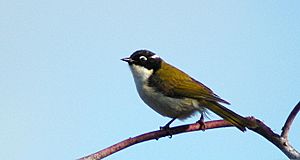Gilbert's honeyeater facts for kids
Quick facts for kids Gilbert's honeyeater |
|
|---|---|
 |
|
| Conservation status | |
| Scientific classification | |
| Genus: |
Melithreptus
|
| Species: |
chloropsis
|
| Synonyms | |
|
|
The Gilbert's honeyeater (Melithreptus chloropsis) is a special bird from the honeyeater family. It is also known as the Swan River honeyeater or western white-naped honeyeater. This bird lives in southwestern Australia.
It is a medium-sized honeyeater. Its back is olive-green, and its belly is white. It has a black head, neck, and throat. You can spot a white patch above its eye. There is also a white crescent shape on the back of its neck. Its beak is brownish-black, and its eyes are a dull red color. Male and female Gilbert's honeyeaters look very much alike.
Contents
About the Gilbert's Honeyeater
How it Got its Name
The Gilbert's honeyeater was first described by a scientist named John Gould in 1848. He gave it the scientific name chloropsis. This name comes from ancient Greek words. Chloros means 'green-yellow', and opsis means 'eye'.
Another scientist, Gregory Mathews, gave it a different name in 1909. He called it Melithreptus whitlocki. He thought it was different because it had a white ring around its eye all year. But scientists no longer see this as a special feature.
For many years, this bird was thought to be a type of white-naped honeyeater. However, a study in 2010 showed it was a separate species. It is closely related to the white-naped and black-headed honeyeaters.
Family Tree of the Honeyeater
The Gilbert's honeyeater belongs to a group of birds called the Melithreptus genus. Birds in this group are similar in size. Most of them have black heads, except for the brown-headed honeyeater.
These birds like to find insects in tree leaves or the top parts of trees. They often gather in larger groups. They live in open, dry forests and grasslands.
Scientists have used DNA to study bird families. They found that honeyeaters are related to other bird families. These include the pardalotes, Acanthizidae (like Australian warblers), and Maluridae (like Australian fairy-wrens).
John Gould also called it the Swan River honeyeater. He noted that local Aboriginal people had different names for it. Some names were jingee, bun-geen, and berril-berril. Today, these names might be spelled djinki, bongin, and berilberil. Another name, Djiok, was used near Albany.
What the Gilbert's Honeyeater Looks Like
The Gilbert's honeyeater is a medium-sized bird. Its upper body is olive-green, and its lower body is white. If you ruffle its feathers, you can see that the white and olive feathers have grey bases. The white feathers on its sides have dark tips.
It has a black head, the back of its neck (nape), and throat. There is a clear white patch above its eye. A white crescent shape is on the back of its neck. This white patch is thinner than on other similar birds. Its beak is brownish-black, and its eyes are a dull red.
It is usually easy to tell this bird apart from others in its area. It looks a lot like the White-throated honeyeater. But the White-throated honeyeater lives much further north. It also looks like the Brown-headed honeyeater.
The Gilbert's honeyeater looks very similar to the white-naped honeyeater. Their feathers are almost identical. The main difference is the skin around their eyes. The Gilbert's honeyeater has pale-green to off-white skin around its eye. The white-naped honeyeater has red skin there. Gilbert's honeyeaters also have a longer beak and legs. They are slightly larger overall.
Where Gilbert's Honeyeaters Live
Gilbert's honeyeaters live in the southwest part of Western Australia. They can be found from Moora in the north. Their range goes through the Jarrah forest belt to Broomehill. They also live in the Stirling Range and along the coast to Stokes Inlet.
They prefer dry forests. These forests have trees like jarrah (Eucalyptus marginata), karri (Eucalyptus diversicolor), or marri (Corymbia calophylla). Near the coast, they live in forests with tuart (E. gomphocephala), flooded gum (Eucalyptus rudis), or narrow-leaved paperbark (Melaleuca laxiflora). They also live in wandoo (Eucalyptus wandoo) woodlands.
Gilbert's honeyeaters usually stay in one place. Sometimes they move around locally. Birds living on the Swan Coastal Plain do not move much. However, this bird has become less common on the Swan Coastal Plain. It has even disappeared from Kellerberrin.
Gilbert's Honeyeater Behaviour
What They Eat
Gilbert's honeyeaters mostly look for food in the leaves and flowers at the top of tall eucalyptus trees. Sometimes, they go into smaller plants or on the bark of tree trunks. In one study, they were seen feeding about 7.7 meters (about 25 feet) above the ground.
They mainly eat small creatures like insects. They also enjoy nectar from flowers, manna (a sweet substance from trees), honeydew, and lerp (sweet coverings made by insects).
Life Cycle and Reproduction
The breeding season for Gilbert's honeyeaters is from September to February. They build cup-shaped nests in tree branches. These nests are often hidden by leaves.
The nests are usually made from tree bark fibers, small roots, and dry grasses. They build their nests up to 10 meters (about 33 feet) above the ground. A female usually lays two eggs, but sometimes three. The eggs are pale buff with reddish-brown and grey spots. Each egg is about 18 by 14.4 millimeters (0.7 by 0.5 inches) in size.
Eggs can be found from November to January. The eggs hatch after about 14 days. When the young birds are born, they are naked and their eyes are closed. But they quickly grow soft downy feathers. They stay in the nest for about 14 days before they are ready to fly.
Sounds They Make
Gilbert's honeyeaters have a harsh, scratchy call. They also make a continuous, single tsip sound.
See also
 In Spanish: Mielero nuquiblanco occidental para niños
In Spanish: Mielero nuquiblanco occidental para niños


